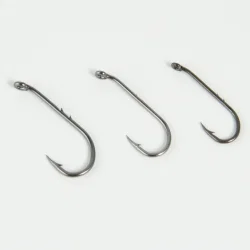Here are key components and aspects of fishing hooks
2023-12-28
Fishing hooks are essential tools used in angling to catch fish. They come in various sizes, shapes, and materials, each designed for specific types of fishing and target species. Here are key components and aspects of fishing hooks:
1. Types of Fishing Hooks:
- Single Hooks: These are standalone hooks with a single point and are used for various fishing techniques.
- Treble Hooks: These have three points and are often used in lures for increased hooking potential.
- Circle Hooks: Designed to reduce gut-hooking in catch-and-release fishing, these hooks form a circular shape.
- Jig Hooks: Commonly used for jigging lures, these hooks have a unique bend and eyelet position.
- Offset Hooks: Ideal for soft plastic baits, these hooks have a slight bend just below the eye.
- Worm Hooks: Specifically designed for soft plastic worm lures, these hooks have a wide gap and a straight shank.
- Fly Hooks: Used in fly fishing, these hooks are typically small and lightweight.
2. Hook Sizes:
- Fishing hooks come in various sizes, and the numbering system is somewhat counterintuitive. Smaller numbers represent larger hooks, while larger numbers denote smaller hooks. For example, a size 1 hook is larger than a size 8 hook.
3. Materials:
- Steel: Most hooks are made of high-carbon steel, which provides strength and durability.
- Stainless Steel: Resistant to corrosion, stainless steel hooks are suitable for saltwater fishing.
- Nickel: Some hooks are coated with nickel for added corrosion resistance.
- Chemically Sharpened Hooks: Many modern hooks undergo chemical sharpening processes for enhanced sharpness.
4. Barbs:
- Hooks may have barbs to prevent fish from easily escaping. Some anglers prefer barbless hooks for easier catch-and-release.
5. Eyelets:
- The eyelet is the part of the hook where the fishing line is tied. There are different types of eyelets, including straight eyes, turned-down eyes, and ring eyes.
6. Shank:
- The shank is the straight part of the hook between the eye and the bend. Different hooks have varying shank lengths and shapes.
7. Bend:
- The bend is the curved part of the hook, and its shape varies among hook types. Common bends include the J-bend, O'Shaughnessy bend, and Aberdeen bend.
8. Point:
- The point is the sharp end of the hook that penetrates the fish's mouth. Hooks can have straight, knife-edge, or needle points.
9. Weighted Hooks:
- Some hooks, particularly those used in bass fishing with soft plastics, have lead or other materials molded onto them to add weight.
10. Snagless Hooks:
- Designed to reduce snagging on underwater structures, these hooks often feature weed guards.
11. Saltwater vs. Freshwater Hooks:
- Hooks designed for saltwater fishing are typically corrosion-resistant to withstand the harsh saltwater environment.
Choosing the right fishing hook depends on the type of fishing, the target species, and the specific technique being employed. Anglers often carry a variety of hooks in their tackle boxes to adapt to different fishing conditions and situations.



